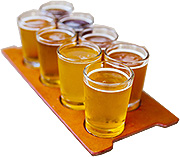

This changed when the longer shelf-life lager styles brought by German immigrants turned out to be more profitable for large-scale manufacturing and shipping. Until the middle of the 19th century, British-style ales dominated American brewing. The brewing traditions of England and the Netherlands (as brought to New York) ensured that colonial drinking would be dominated by beer rather than wine. On February 5, 1663, Nicholas Varlett obtained from Peter Stuyvesant a patent for a brewery on Castle Point in Hoboken, New Jersey. The earliest record of brewing dates from 1587, and the first commercial brewery in the United States was built by the Dutch West India Company in 1632 in Lower Manhattan on Brewers (later Stone) Street. More recent craft styles include American Pale Ale, American IPA, India Pale Lager, Black IPA, and the American "Double" or "Imperial" IPA. Beer styles indigenous in the United States include amber ale, cream ale, and California common. The most common style of beer produced by the big breweries is American lager, a form of pale lager small breweries, most of which were founded since the 1980s, produce a range of styles. Many craft beer drinkers select beer based on the ABV and IBU percentage, in order to determine the hops and the alcohol percentage. Different types of beers that craft breweries normally produce are wheats, sours, IPA, pale ales, and lagers. People travel all over the world just to try out different breweries. Breweries are growing rapidly around the United States. over the past three decades have been small breweries and brewpubs, referred to as " craft breweries" to differentiate them from the larger and older breweries. However, the majority of the new breweries that have opened in the U.S. Many of the big breweries that returned to producing beer after Prohibition, today largely owned by international conglomerates like Anheuser-Busch InBev, still retain their dominance of the market in the 21st century. After the repeal of Prohibition, the industry consolidated into a small number of large-scale breweries. Īlthough beer was a part of colonial life in the United States, the passing of the Eighteenth Amendment to the United States Constitution in 1919 resulted in the prohibition of alcoholic beverage sales, forcing nearly all American breweries to close or switch to producing non-alcoholic products. In 2011, the United States was ranked fifteenth in the world in per capita consumption, while total consumption was second only to China. The United States produced 196 million barrels (23.0 GL) of beer in 2012, and consumes roughly 28 US gallons (110 L) of beer per capita annually. Modern American pale ale made by Sierra Nevada Bottles of a craft brewed black lager and a mass produced malt liquorīeer is manufactured by more than 7,000 breweries in the United States, which range in size from industry giants to brew pubs and microbreweries. For the Fear album, see American Beer (album).

For the documentary film, see American Beer (film).


 0 kommentar(er)
0 kommentar(er)
